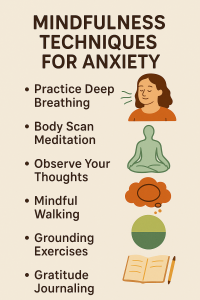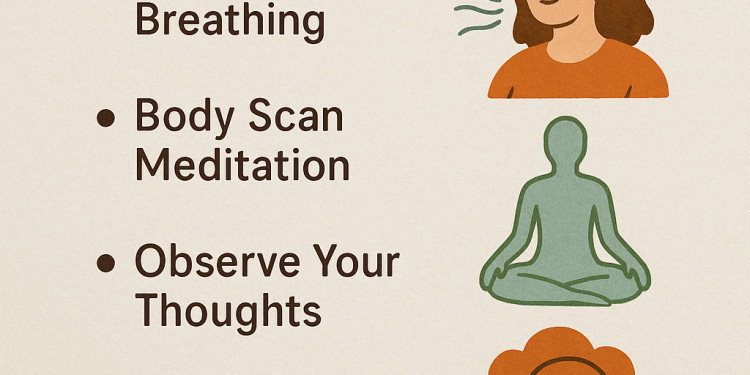Introduction mindfulness techniques for anxiety: Feeling Anxious? You’re Not Alone
In our fast-paced, hyper-connected world, anxiety has become a common companion. Whether it’s a racing heart before a presentation, sleepless nights over finances, or that gnawing unease with no clear cause—anxiety affects millions daily. In fact, over 284 million people worldwide struggle with anxiety disorders, according to the World Health Organization.
If you’re tired of feeling overwhelmed and wired but tired, it’s time to explore mindfulness—not as a buzzword, but as a practical, powerful tool.
So, what if you could anchor yourself in the present moment and find calm within the chaos?
In this article, we’ll dive into effective mindfulness techniques for anxiety—backed by research, practiced by millions, and simple enough to start today.
What Is Mindfulness?
Mindfulness is the practice of paying attention to the present moment without judgment. Instead of getting swept away by anxious thoughts, mindfulness helps you pause, observe, and reset.
Originally rooted in Buddhist traditions, mindfulness has now gone mainstream, thanks to research showing its benefits in reducing anxiety, improving sleep, and enhancing emotional well-being.
Quick Definition:
Mindfulness = Awareness + Acceptance.
You’re aware of what’s happening now (thoughts, emotions, body), and you accept it without resisting or reacting.
Why Mindfulness Works for Anxiety
Anxiety thrives on two things: future-oriented thinking and avoidance. Mindfulness flips both on their head.
Here’s how mindfulness helps:
- Breaks the worry loop by grounding you in the present.
- Reduces reactivity by teaching you to observe thoughts instead of believing them.
- Improves emotional regulation through repeated practice.
👉 A 2013 meta-analysis in Clinical Psychology Review found that mindfulness-based therapy was “an effective treatment for anxiety disorders.”
1. Mindful Breathing: Your Portable Calm
The breath is always with you—which makes it a powerful anchor.
Try This: The 4-7-8 Breathing Technique
- Inhale for 4 seconds.
- Hold your breath for 7 seconds.
- Exhale slowly for 8 seconds.
- Repeat for 4–6 cycles.
This technique activates your parasympathetic nervous system—your body’s natural “rest and digest” mode—reducing heart rate and calming your mind.
2. Body Scan Meditation: Reconnect With Your Body
Anxiety often lives in the body—tight shoulders, clenched jaw, fluttering chest.
What to Do:
- Lie down or sit comfortably.
- Start at your toes and mentally “scan” upward, part by part.
- Observe any tension, tingling, or sensations without judgment.
This technique helps you release physical tension and notice how anxiety shows up in your body.
3. The STOP Method: A Mindfulness Mini-Reset
Anxiety can hijack your day in seconds. The STOP method interrupts that spiral.
S.T.O.P. stands for:
- S: Stop what you’re doing.
- T: Take a breath.
- O: Observe what’s happening (thoughts, feelings, surroundings).
- P: Proceed mindfully, with intention.
Use this when you’re triggered—whether in a meeting, traffic jam, or awkward conversation. It’s like a reset button for your nervous system.
4. Five Senses Grounding Technique
This is one of the most effective mindfulness techniques for anxiety attacks or sudden panic.
How it Works:
- 5 things you can see
- 4 things you can touch
- 3 things you can hear
- 2 things you can smell
- 1 thing you can taste
This grounds your awareness in the present moment and shifts focus away from your anxious thoughts.
🖼️ Infographic Tip: Create a quick-reference “5-4-3-2-1” grounding chart to boost engagement and social shares.
5. Mindful Journaling: Make Sense of the Storm
When your mind feels like a browser with 50 tabs open, writing things down helps organize the chaos.
Journaling Prompts for Anxiety:
- What am I feeling right now?
- What thoughts are fueling this anxiety?
- Is this thought 100% true?
- What can I do in this moment?
You don’t have to be a writer. Just be honest. Mindful journaling can externalize your anxiety, making it feel less overwhelming.
✍️ Pro tip: Use apps like Day One or a simple Google Doc.
6. Walking Meditation: Movement Meets Mindfulness
You don’t have to sit cross-legged for mindfulness to work.
How to Practice:
- Walk slowly in a quiet place.
- Feel your feet touching the ground.
- Notice the movement of your legs and arms.
- Observe your surroundings with fresh eyes.
Walking meditation is perfect for those with racing thoughts who find stillness uncomfortable.

7. Loving-Kindness Meditation (Metta): Heal Through Compassion
Anxiety can make us harsh critics of ourselves. Loving-kindness meditation invites you to soften.
How It Works:
- Close your eyes and repeat silently:
- May I be safe.
- May I be healthy.
- May I be free from suffering.
- Extend those wishes to others—friends, strangers, even people you struggle with.
Studies show that compassion-based meditation lowers anxiety and increases emotional resilience.
8. Digital Detox Mindfulness
Scrolling TikTok at 2 a.m.? That blue light isn’t helping.
Mindfulness includes being aware of your digital consumption.
Mindful Screen Habits:
- Turn off notifications.
- Set “screen-free” hours.
- Replace doomscrolling with a 10-minute breathing break.
💡 Interesting Stat: The average person touches their phone 2,617 times per day (source: Dscout Study). Mindfulness helps reclaim that time.
Integrating Mindfulness Into Your Daily Life
Mindfulness isn’t just a technique—it’s a lifestyle shift.
Here are simple ways to embed mindfulness into your day:
| Moment | Mindful Action |
|---|---|
| Morning shower | Feel the water, smell the soap |
| Coffee break | Savor each sip, no scrolling allowed |
| Commute | Listen to your breath or sounds around |
| Mealtime | Chew slowly, notice taste & texture |
| Bedtime | Do a 2-minute body scan |
No need to overhaul your life. Small, consistent moments of presence can transform how you respond to anxiety.
Final Thoughts: Breathe In, Breathe Out
Anxiety may be a part of your life—but it doesn’t have to define it. Through mindfulness, you gain the power to respond instead of react, to pause instead of panic, and to reconnect with the calm that’s always within you.
Whether you start with a single breath, a 2-minute journal entry, or a walk in the park, remember:
Mindfulness isn’t about perfection—it’s about presence.
If this post helped you, consider sharing it with a friend who could use a little calm today. Or drop a comment below:
✨ What’s your favorite mindfulness practice for anxiety?


